Publikations
Tique
Publikation on contemporary art
SIX QUESTIONS FOR KIRSTIN ARNDT
Tique asks six questions to an artist about their work and inspiration.
September 2023
https://tique.art/
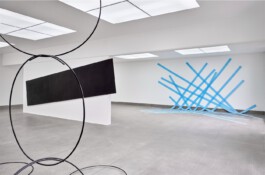
How do you describe your own art practice?
My way of looking and thinking is phenomenological. I understand my work as experimental, open-ended and the artworks are a result of my reflections, research and experimentation. The work process includes both planned and targeted interventions as well as chance-based (guided chance) actions.
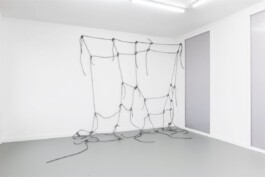
Exhibition view, Shimmer, Rotterdam, NL, 2023
KIRSTIN ARNDT - Untitled, 2015
PVC-rope, silver (diameter 10mm), 330 x 440 x 80 cm / height here ca. 240 cm. Photo credits: jhoeko
Copyright for the art works of Kirstin Arndt: VG Bild-Kunst, Bonn 2023
Which question or theme is central in your work?
States – possibilities of being in space.
Wrestle and release – I consider these actions in my work and choose the materials accordingly or, I work in series or modules. The acts of wrestle and of release must occur again and again until a moment is achieved where these phases are completed; where concepts, their realisation, materiality and form unite in a perfect state in space. This state can be an end point but often this state exists only for a limited period of time and in relation to spatial conditions which can alter the works’ shape. With my “LED works”, for example, I react to the conditions of the environment in which they are exhibited. The dimension of the installation reflects the scale of the wall on which the work is located, thus transforming a materialised surface/area into a linear, luminous structure.
My interests in quantum physics, meteorite impacts, volcanic eruptions, minerals and archaeology – especially in cave paintings, sculptural works and early tools compliment my reflections and investigations.
Our human existence is based on matter/materia and energy. Nature, as well as the environment that we humans create, the space, the things, structures, can be retraced to point-shaped, linear or two-dimensional basic structures. From this, I begin my artistic work.
I use simple materials and forms:
– punctiform (e.g. plaster, cement, sand, etc.)
– linear (e.g. yarn, rope, wooden sticks, metal rods, tubes, etc.)
– flat (e.g. plates, boards, textile sheets, tarpaulins, foils, etc.)
By applying energy (labour or machine power), I transfer these basic materials from their original dimensions and useful purpose into a reconstructed form that reactivates the environment they occupy.
Further areas of interest that derives from this are:
– connections, linkages, knotting, interweaving, net structures and relationships
– changes of dimension, increasing and decreasing the occupation of space
– foldings, curvatures, bends
– expansion/extension, stretching, compressing
Through my experimentations manipulating materials or objects, I explore their potentials and limits. I am interested in materials’ statics, their positional possibilities, their qualities in space and how, taken all together, that can alter an environment.
I often relate my work to the architecture of the exhibition spaces and their internal spatial structures. In addition to investigations of material properties and formability, I’m interested in the process of form-finding, which is essentially determined by guided chance, gravity and the inherent law of the material. If colour also comes into play, that becomes part of my investigation into its effect on the space/environment.
And, I develop series with similar or even identical modules which allow me to examine the relationships of the elements to each other and/or in relation to the space or architecture. The spatial effect of the same elements on different walls is unique so different elements of these constellations become evident.
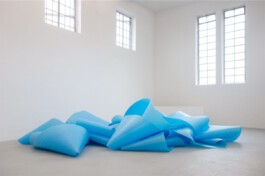
Exhibition view, Fuhrwerkswaage, Kunstraum, Cologne, GER, 2016
KIRSTIN ARNDT - Untitled, 2016
PE (footstep sound insulation, light blue) ca. 120 x 800 x 400 cm (scale: 1:1, West wall area, inside)
Photo credits: Achim Kukulies
Copyright for the art works of Kirstin Arndt: VG Bild-Kunst, Bonn 2023
What was your first experience with art?
As it so often is, my first experience with art happened in childhood. When I was 5 or 6, my father took me to a local art exhibition – nothing special, but I was excited about painting itself. Back home my father gave me a catalogue by Picasso and I remember that I thought, I’m able to do this too… So I started copying his Cubist technique using markers on paper, but I changed the subject and the colour shades – his female portraits were replaced by cats and vases with flowers.
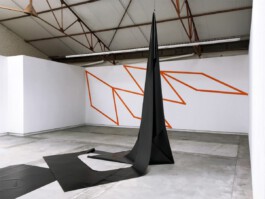
Exhibition view, Loods12, Wetteren, BE, 2019
KIRSTIN ARNDT - Untitled, 2019 (ceiling - floor)
PVC-tarpaulin, black, with cut (250 x 500 cm), eyelet, elastic rope, black; installed: ca. 400 x 300 x 250 cm
KIRSTIN ARNDT - Untitled, 2019
Aluminum, powder coated, orange (RAL 2009), dimension flexible, here: ca. 800 x 300 x 1 cm
Photo credits: Kirstin Arndt
Copyright for the art works of Kirstin Arndt: VG Bild-Kunst, Bonn 2023
What is your greatest source of inspiration?
This is a difficult question because, obvious as it sounds, all or everything – life! Inspiration is always near. It comes in many unanticipated forms – fresh or rotten strawberries, music, a poem or a conversation between customers at the petrol station while refuelling the car…

Exhibition view, Kunstraum Düsseldorf, GER, 2013
KIRSTIN ARNDT - Untitled, 2013 (Diptychon)
2 tarpuline (PVC, black): 400 x 250 cm, 2 steel pipes ø 42 mm , galvanized; installed: each 295 x 350 x 77 cm
KIRSTIN ARNDT - Untitled, 2013, 10 modules
wood (40 roof battons, each 270 x 3,4 x 1,7 cm), Acrylic paint, sulfur yellow; installed: ca. 400 x 400 x 20-30 cm
Photo credits: Achim Kukulies
Copyright for the art works of Kirstin Arndt: VG Bild-Kunst, Bonn 2023
What do you need in order to create your work?
Time and a quiet space with a high ceiling – for thinking.
What work or artist has most recently surprised you?
It changes – there are so many excellent contemporary and older artists. Recently, the contemporary Irish art scene has caught my interest, for example works by Niamh O’Malley, Aleana Egan or Niamh McCann as well as Nina Cannell, Edith Dekyndt or Thea Djordjadze. Bruce Nauman always surprises me, but my interest is also excited by the work of Charlotte Posenenske and the late works of Robert Ryman and I should also mention Michel Francois, Anne Imhof, Eva Hesse, Thomas Hirschhorn, Norbert Kricke, Gordon Matta Clark, Gary Kuehn, Steven Parrino, Jason Rhoades, Roman Signer, Jessica Stockholder, Tatjana Trouvé, Rosemarie Trockel, …
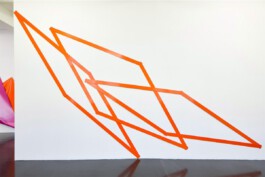
Exhibition view, Galerie Mathias Güntner, Hamburg, 2023
KIRSTIN ARNDT - o.T., 2019
Aluminum (2 mm), powder coated, orange (RAL 2009)
variable: (here ca.: 300 x 500 x 1 cm)
(aluminum strips, each 200 x 7 x 0,2 cm)
Photo credits: Marcel Stammen
Copyright for the art works of Kirstin Arndt: VG Bild-Kunst, Bonn 2023
Wrestle – Release
Introduction to the exhibition at Kunstverein Mönchengladbach, 12.03.–31.05.2020
Dr. Maria Müller-Schareck, Curator, ‘Kunstsammlung Nordrhein-Westfalen’, Düsseldorf
Kirstin Arndt gives us a two-concept title to her exhibition in the ‘Kunstverein’ in Mönchengladbach; it will take place in the open, two-storeyed hall of a former textile factory on the edge of town. The two concepts have everything to do with the field of artistic activity: ‘Wrestle – Release’. ‘Wrestle’ is associated with the actions, for example, of struggle, argument, exertion, but also with the overcoming of difficulties and the striving for spiritual freedom; ‘Release’, meanwhile, applies to the conscious – or even simply intuitive – letting go, stopping (as in the termination of action), leaving something be, and as it is for a while, or even discarding something. The artist thus encourages us to view the decisive point in the creative process: the moment in which the active phase has been concluded, in which conception and realisation, idea and form are in perfect harmony. And that’s it.
The phase of the ‘wrestle’ in which both the physical altercation with an opponent, and the philosophical aspects of a wrestle for knowledge and truth are touched upon, is always, with Kirstin Arndt, a search for associations: connections between the work itself and its location. Many of the artist’s creations have no stable form – they rather exist as elements added to each other: depots of materials with specific characteristics which are linked with cord, rings, loops, and hooks. They thus allow for many different ways in which they might be classified or arranged in a particular sequence; this leaves room for them to respond to a variety of spatial situations.
Everything is built on the basic elements of artistic form: line; surface; colour. Once the form is transposed into the location, this becomes the area of reference, along with its associated walls, ceiling and floor. The lines are poles or bars made of wood or aluminium; there are plastic strips or even neon tubes, yarns, cables, ropes and cords. Surfaces take the form of rigid or flexible materials, metal plates or sheet metal, paper, wooden boards and roof panels, PVC tarpaulin, packaging materials, layers of foam, painters’ felt or fleece blankets. These products were developed outside of the artistic world and are able to enrich the latter with their particular qualities. Kirstin Arndt will often use the colours available from production in industry – she prefers black, metallic shades, a light blue, a powerful orange – or she gets professionals to spray the surfaces according to her instructions. The overlap between workshop and industrial production is therefore a broad one. Kirstin Arndt brings together the elements in the location as a temporary shut-down; but this, nonetheless, in no way dampens the acknowledged changeability of most of the works and thereby offers the option of renewed activity.
For example, this is the case in a group of formations made of rings: circular rounded, blackened steel rods with differing diameters are strung together; a single ring is fastened on a cord above your head, and then the ‘chain’ continues on, tumbling from its secured position. You examine the links, you notice the various sizes of the rings, you count and wonder: is everything simply random, or is there some sort of underlying system? Indeed the total number of all the rings of two or three metres’ circumference corresponds to the length of the surrounding walls of the room in which the rings are installed: 59 metres in this case. This measured line is divided and distributed amongst the rings; the number of these is dictated exclusively by the dimension of the room. The artist is thereby following a self-imposed rule: she accepts the dimensions of the room as a given size and she transposes this into a modular system which offers her separate spheres in which to operate. She alone decides how the rings are strung together and how they are positioned and therefore how they relate to each other and to the location itself: hanging in front of the wall; hitting the ground; lying on the floor, or resting against a wall.
The ring is a frequently used tool –, whether used as a circular form, a connecting element or as a loop – and it serves at the same time as a metaphor for connections in general. A wide range of other techniques is also used: knotting; entanglements; braiding; weaving; stacking and, likewise, leaning; affixing; hanging and laying down. The cords which have been knotted and twined around a sheet of metal* or the brightly orange painted metallic strips which are in a rhombus-shaped arrangement appear as net-like structures and can be seen as a sketch or a drawing within the room. The intertwining tracks of a material made of foam for the soundproofing of footsteps make up a voluminous, amorphous form*. The flexible matting of the light blue plastic foam strips which have been woven just like chamfered, the step-like mauve painted metal plate seems to soften the border between the floor and the rising wall. The square piece of a compressed truck tarpaulins fixed to the wall and arches into a plastic form; a similar piece of black tarpaulin, which has been attached at its corners and separated, partially, by a precise incision, unfolds, and fuses the room and its contents into a scene full of contrast. And finally, we might mention a new work made from standard commercial dark grey fleece coverings. Each one displays an eyelet by which they are tied, as well as four attachment tags: short stripes of white, which, whilst only marginally off-centre, are painted onto the edges of the textiles. These tags remain purely as something extra – something optional. Indeed, the hanging coverings take the shape of a rising cone to which a few crumpled layers lying on the floor are drawn, pulled along by the connecting cord. Folded layers are piled, ready for further use, in a kind of material depot. Here we have three situations which demonstrate emphatically the arch of tension between things active and things set aside.
These works are made of the artist’s specified components – characteristics of the material, its form and coloration, the combination of similar or different elements, their order and position in the location, encompassing the never quite controllable conditions of gravity and chance. The point in time to release has been reached only if the material, in its specific constellation, has been introduced into a context. This moment is never one for leaving or rejection, however, but it simply marks the provisional end of activity (wrestle).
In his text ‘Anti-Form’ (published in April 1968 in Artforum), Robert Morris questioned the dictates of ‘forms projected in advance’ over material and remarked that ‘random piling, loose stacking, hanging, give passing form to the material’. This knowledge characterises and stimulates Kirstin Arndt’s artistic process. Her attempts at organising a system of form, target something beyond, even, ‘passing form’. There is an obvious, vital interest in heterogenous materials and new products which can only be employed when their characteristics and plastic behaviour are sufficiently tested. She also creates her works by addition and thereby imparts mutability to them. The positioning in the room, which reflects the scope both of the concept and of the presentation, dictates not just the way in which the viewer appreciates the work, but it also ensures that its shape is reassessed in a new way, time and again.
Kirstin Arndt’s works are approachable, not just physically, but also because the materials are familiar to us in our daily life, because we can see ourselves reflected in them either actually or figuratively, and because they stir up associations and they evoke moods.
We are bound to ask ourselves: what do rings do, as they hang down a white wall from the ceiling like the components of a chain, clasping one another? Are they decorating the room, or are they just putting the room on the chain or are they dancing? What are the blankets doing? Resting? Warming the cold floor? Is a pack of wolves racing after their leader? What would happen if the cord from the ceiling were to break? How do the rugs, hanging cosily side by side, react to the depot of blankets carefully folded and stacked in layers? What does the black truck tarpaulin do – does it cuddle up to the wall? Is it breathing? Which powers have formed the deep folds and arches?
The activation of the material has been provisionally halted by the artist for the duration of the presentation and – you could look at it like this – temporarily handed over to the sensitive receptive faculties of those viewing it. In this regard, ‘Wrestle – Release’ does not simply describe artistic involvement but also the receptive process which is always governed both by a struggle for comprehension and knowledge, and by the more passive ‘aesthetic pleasure’. In any case, a reaction is called for. For if no one reacts – as Agnes Martin put it in 1966 – there is, ergo, no artistic piece.
(Works marked with an asterisk * do not form part of this exhibition.)
Translation: Robert Giles